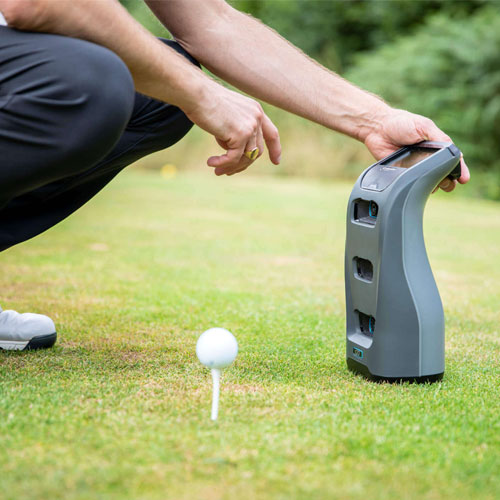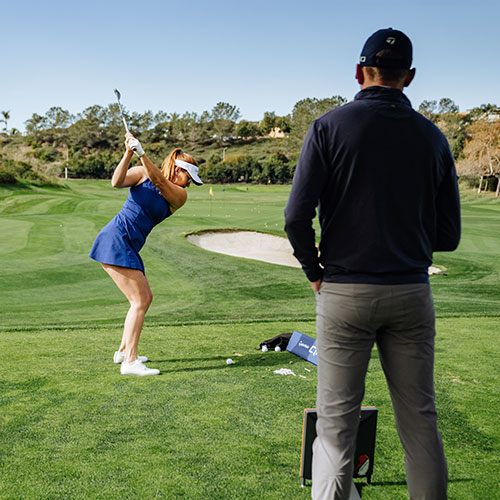At Click Golf, we're often asked about golf club distances and how far you can expect to hit each club in your bag. It's one of the most common questions from beginners looking to get a handle on the game, as well as more experienced players hoping to fine-tune their strategy and club selection on the course.
Knowing your typical golf club distances is absolutely critical for playing smart golf and shooting lower scores. Hit the ball 20 yards too far, and you could sail the green into trouble. Come up 20 yards short, and you might find a hazard or a thick, rough area. Being properly distanced for your approach shots and being able to pick the right club is crucial.
But how do you determine your personal golf club distances? What are the average golf club distances for amateur and professional golfers? And what factors can affect golf club distance in your golf club set?
In this comprehensive guide to the golf club distance charts and averages, we'll dive into all of those key topics and more to help take the mystery out of this critical part of the game. Let's get started!

While things like club head design, loft, shaft flex, and other equipment specs obviously play a major role in how far you can hit each golf club, there are a number of personal factors that dictate your average distances as well.
The single biggest influence is your swing speed at each golf club. The faster you can swing a driver, for example, the more ball speed you'll generate and, therefore, the greater the total distance you'll achieve off the tee.
Age, physical fitness levels, driver swing speed, and skill level also have a significant effect on distance. Tour pro golfers in peak physical condition will obviously hit their clubs (especially drivers) much farther than a beginner golfer or senior amateur with a slower, less powerful swing.
Finally, weather conditions like temperature, wind, and elevation can add or subtract distance from your typical golf club yardages. A hot day with the wind at your back will add carry. Cold temperatures and a head wind will knock distance off your shots.

With those key factors in mind, let's look at some average distance numbers for male golfers across different skill levels:
As you can see, there's a pretty wide range between PGA Tour players who can absolutely crush the golf ball and the average weekend warrior. Tour pros will hit most of their clubs 30-50 yards farther than a mid-to-high handicapper with the same club and the same swing speed.
It's also worth noting that distances can vary greatly within each skill level. Long hitters at any level of golf expert often will outdistance their peers with the same golf clubs. So don't get too caught up comparing your numbers to averages. Focus on your game and maximise your distances.
On the LPGA Tour and among female amateur golfers, you'll obviously see slightly shorter distances than their male counterparts. But the spread and relationships between different skill levels follow a similar pattern:
As with the men, the club speed, head speed and overall athletic ability are the biggest determinants of how far female golfers can hit each club. But intelligent course management and careful club selection become even more important when you're not hitting it as far off the tee or into greens.

Now that you have a sense of some typical distances for different skill levels, you're probably wondering - how far do I personally hit each golf club in my golf bag?
The best way to gauge your yardages is to spend some time on the driving range or a course hitting balls and tracking the distances of your shots. Using a laser rangefinder or a GPS app can give you precise measurements.
When tracking your average swing speed and distances, be sure to hit a series of shots with each golf club rather than just a single golf ball. That will give you a better sense of your average vs. just one outlier number that was shorter or longer than normal.
Ideally, chart your shots over multiple sessions in different conditions. That way, you can get a sense of max distances vs. average and identify any discrepancies between your driving range and on-course numbers.
Pay close attention to easy-to-remember yardages for your go-to clubs, such as the Driver, 3-wood, Hybrid, and Irons; 7-iron, pitching wedge, and sand wedge. Knowing those key numbers can simplify decisions and make club selection easier when you're out on the golf course.
For most golfers, there's always room to add a few yards of extra distance. If you'd like to increase the maximum distance of how far you hit each club in your bag, here are some tips:
At the end of the day, maximising your personal distances by making some adjustments can go a long way toward shooting lower scores and having more fun out on the golf course.

While comparing your golf club distances to averages for tour pros or other skill levels can provide some useful context, the most important numbers are your own. Knowing how far you typically hit each club is the foundation for smart strategy, target selection, and scoring well.
Take the time to figure out your specific averages, focus on factors you can control to play golf well, like fitness and technique, and don't get too hung up chasing what others can do. With a few extra yards here and there, the right plan of attack, and a commitment to practising with purpose, you'll be well on your way to playing better golf.
Do you have any other questions about optimising your golf club distances or looking for some personalised advice? Don't hesitate to reach out to our golf experts here at Click Golf. We're always happy to help!